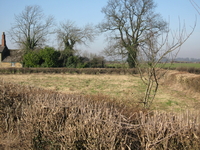Drovers' Inns
I've been told there was an inn on average every four miles on a busy route like the one from North Wales. The smaller ones (alehouses) have disappeared altogether; nearly all the larger ones are now farms or private houses. The pubs that still survive are mostly on the turnpikes (now A-roads) which replaced the old routes in the 18thcentury. The others lost their customers because they tended to be built in the middle of nowhere: drovers liked to avoid contact with local herds.
Most drovers' inns seem to be large and rambling, near a crossroads and with plenty of outbuildings. The Magpie (first picture) has a barn at the side for the lead drover to sleep in and a triangular ‘stance' opposite for the cattle (picture #2). The triangle was not accidental: it was easier to drive beasts into a ‘gore' because they couldn't escape round the side of you during the process.
Landlords charged a lot for grass, but welcomed the manure dropped by the beasts so much that they were known to offer the men an extra breakfast free of charge in the hope of more contributions.
One farmer's wife told me that the boys outside guarding the cattle at night used to let them settle down for an hour or so, then kick them and lie down in the warm spot. “There's a boiler inside every rumen,” as another farmer put it.








